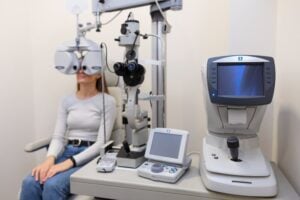What is Presbyopia?
Presbyopia means those close-up tasks aren’t as effortless as they used to be. This usually happens sometime after you turn 40. It’s frustrating, but it’s also very fixable.
Different symptoms manifest when you suffer from presbyopia. The classic signs of presbyopia include:
- Difficulty focusing on close objects
- Eye strain when reading
- Blurry vision when reading small print
- Need for more light
- Headaches when working on near objects
- Need to hold reading material at arm’s length
Presbyopia is a normal part of aging eyes. It’s not something you can prevent, and it will slowly worsen until it usually levels off in your mid-60s.
Why Does Presbyopia Happen?
Presbyopia is caused by the natural aging process of the eye’s lens. Over time, the lens hardens and becomes less flexible, making it difficult to quickly adjust focus for close-up vision.
The muscles around the eye also contribute to presbyopia. Tiny muscles around the eye’s lens help it change shape, and these weaken over time.
How Is Presbyopia Diagnosed?
Getting a proper diagnosis from your doctor is the first step towards finding the right solution for your presbyopia.
During the visit, your doctor will conduct an eye chart test. This simple test will determine whether your distance vision is okay while your near vision is blurry.
This is where they ask you to read something up close and watch you struggle. Using special instruments, they check how well your lens is focusing light.
Can You Treat Presbyopia?
Yes, presbyopia is treatable. While we can’t reverse this aging process, treatment options keep improving. What’s right for you depends on your eyes, lifestyle, and preferences.
Corrective Lenses
Corrective lenses are one of the most common and effective treatments for presbyopia:
- Reading glasses. These single-vision lenses are ideal for close-up tasks like reading, writing, or computer use. They’re readily available, affordable, and easy to use.
- Bifocals. Bifocals combine two distinct prescriptions into a single lens. A clear line across the middle separates reading and distance power.
- Progressive lenses. These lenses have no lines, and the power changes gradually from top to bottom—they’re more natural–looking.
- Contacts. If you already wear contacts, multifocal versions, and the less-common “monovision” approach are available.
Surgery
Surgery is a good option for those who want to stop wearing glasses. Surgeons can adjust LASIK and similar procedures for monovision.
Implanted lenses can also create a similar effect as multifocal glasses. These lenses provide a range of vision corrections, allowing patients to achieve spectacle independence.
Management Techniques for Presbyopia
Presbyopia might feel like a major life change, but managing it doesn’t have to be overwhelming. Small, strategic changes in your environment and habits can make a huge difference for your eyes.
Brighten Up Your Surroundings
Good lighting is key to reducing eye strain. When reading, try having a lamp focused right on what you’re doing, along with general light in the room.
Avoid glares, too. Harsh reflections on screens or glossy pages are enemies of easy reading. Change your angle or the light source to minimize these.
Be Gentle to Your Eyes
When reading, find your sweet spot. Experiment with holding things a bit further away to see what’s comfortable. This can be slightly different for everyone.
Bump up the font size on your phone or tablet, and don’t be afraid to zoom in on websites when you’re on your computer.
Don’t forget your glasses, too. If you have corrective lenses for presbyopia, remember to use them. Otherwise, you’re just making your eyes work harder.
Give Your Eyes a Break
Follow the 20-20-20 rule. Every 20 minutes, look at something at least 20 feet away for 20 seconds. This lets your eyes relax their focusing muscles.
Take regular mini-breaks when working on a project. Even just standing up and stretching can help your eyes switch gears.
Being tired or stressed can worsen eye strain. Self-care practices like getting good sleep, staying hydrated, and taking short walks for fresh air can protect your eye health (and mood).
In this article







